|
2010 Carolina Wren Nesting
|
| Our Carolina wrens have been having two broods each year since 2004, and usually in surprising places. This year the first nesting was in an old gourd hanging in the entrance way to the lower workshop. This gourd is provided for house wrens, to keep them away from the nest boxes. House wrens had used it every year lately, so I didn't realize that it was being used by Carolina wrens until the young were almost ready to fledge. When they did fledge, several ended up in the workshop, scurrying around under the machines and benches. Both adult and juvenile Carolina wrens usually take evasive action by keeping low and hiding under things, rather than the usual avian response of flying up up and away. After trying to coax the fledglings out of the shop for several minutes, it became apparent that even finding all of them under the various machines was an impossible task, let alone catching them. But, a large door at the opposite end of the shop allowed the adults to find and feed the young. Several hours later, four nestlings were observed on vines along the barn wall. |
| |

|
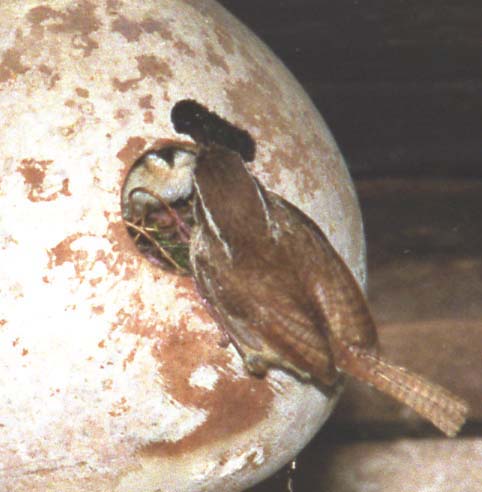
|
| The wrens moved to the second floor shop for their second nesting. As usual, their nest site selection was unfortunate (for me), but it worked out well for them. They built on a batten adjacent to a light switch that I must use when entering the second floor of the barn at night. This meant that I had to leave the second floor before dark, since reaching for the light switch would scare the female off the nest and she might not be able to return to the nest in the dark. She didn't mind my approaching within 4 or 5 feet of the nest, so we coexisted nicely during the day. Or, more likely, she endured my close approach because she didn't want to give away the location of the nest by flying off. |
| |

|
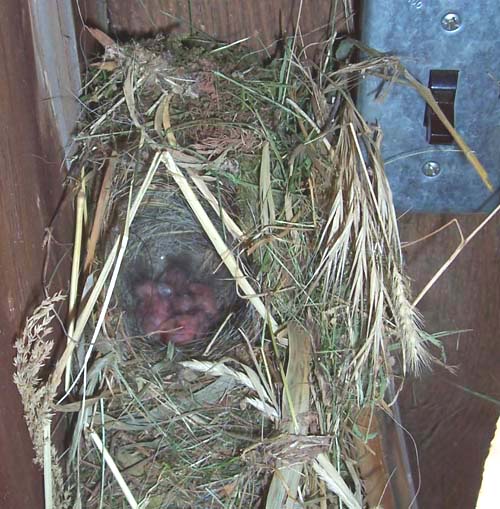
|
| I placed a video camera several inches from the nest and recorded video on several days. The photos were taken remotely while watching live video. Each night all windows and the large rolling doors of the second floor are closed to keep out the big brown bats, but the wrens were using an opening unknown to me to enter without needing to wait for me to open the doors. There was a small knot hole close to their nest and narrow openings around the big doors, but I never noticed which the wrens might be using. |
| |

|
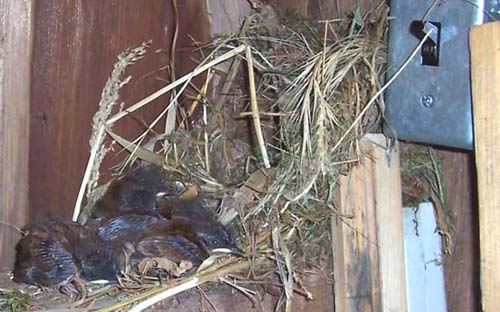
|
| |
Five hungry nestlings kept both adults busy |
The nestlings always leave the nest one to three days before their first flight.
|
While the female was incubating or brooding, the male would often perch just inside the big door and break out in song. This was often the familiar "tea kettle - tea kettle - tea kettle" call, but he had several other variations. His singing was loud and seemed amplified in the cavernous barn. I was always pleasantly startled when the silence would be suddenly broken by such vociferous song.
As always, the five young left this nest before they could fly and were fed on the floor the first day. By the second day, they were flying and out of the barn. In previous years, the newly fledged wrens would often hop and climb around for 3 days before their first flight. |
| |
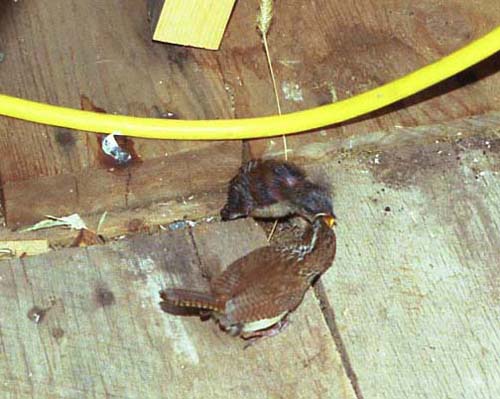
|
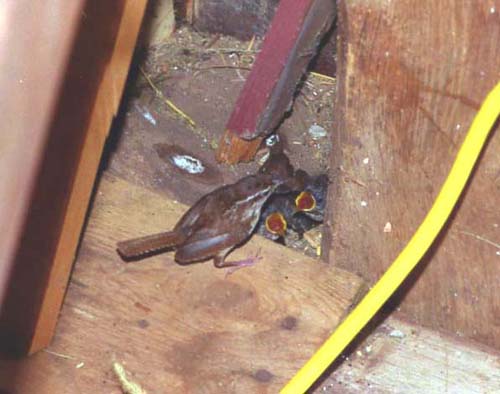
|
| |
The first nestling to jump to the floor
|
The others soon follow
|
| |
. |
. |
|
2019 Carolina Wren Nesting
|
| This year, the wrens chose the third floor of the barn for their first nest. They had nested in the same location in 2018, but, this year, moved one shelf higher, rather than reusing their old nest. While this location gets much hotter than their nest sites on the second or first floors, they seem to know what they are doing. Carolina wren nestings in recent years have been 100 percent successful with all nestlings fledging. |
| |
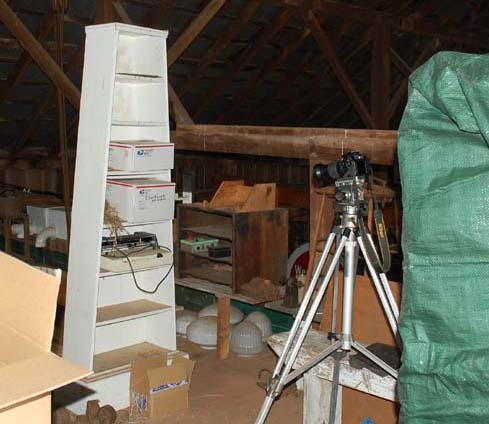
|

|
|
A blind was left in place for the duration of the nesting and photos were taken remotely.
|
| |

|
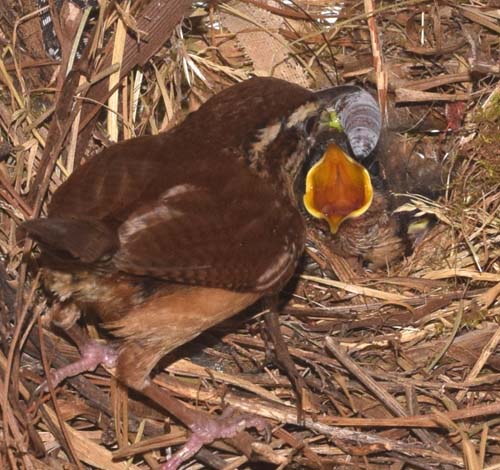
|
| |
Of the five nestlings present, one was almost always hidden from view. I think it was the same one, which reminds me of this year’s kestrel nesting in box “A”, in which the lone male usually hid behind the 4 females. |
Surprisingly large prey items were brought to the nest and shoved down the throat of eager nestlings whose flattened triangular tongue is kept well out of the way. Also, spiders are a favorite prey of the Carolina wren, and, during inclement weather, can be readily obtained inside the barn. |
| |
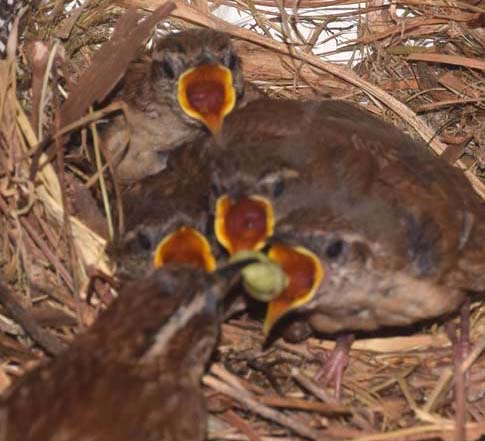
|
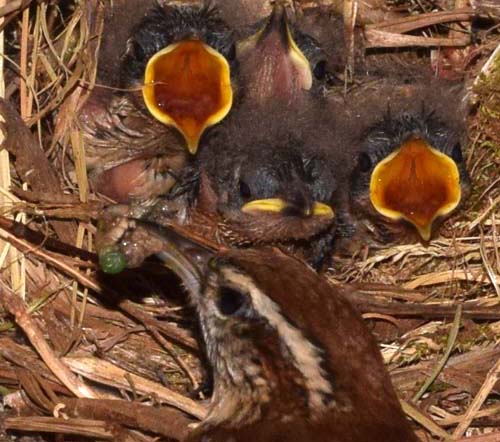
|
| |
|
|
| |
|

|
|
2020 Carolina Wren nestings
|
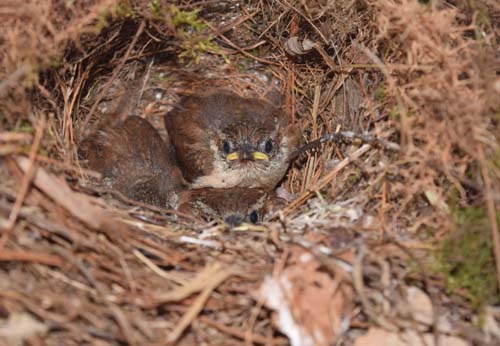
|
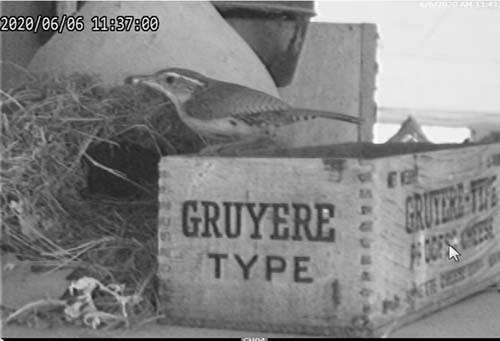
|
The first nesting in 2020 was in the darkroom, reusing one of the two nests used in previous years. The darkroom would give them the greatest privacy of the three locations they routinely use. It would also avoid the bright lights in the evening when I am making the swallow nest cups.
|
For the second nesting, the wrens returned to the same cabinet top in the workshop. Their coming and going while renovating the old nest moved the cheese box, likely by their frequently landing on it and then kicking off as they launched themselves into the air. For a bird that weighs almost nothing, they seem to have powerful legs. |

|
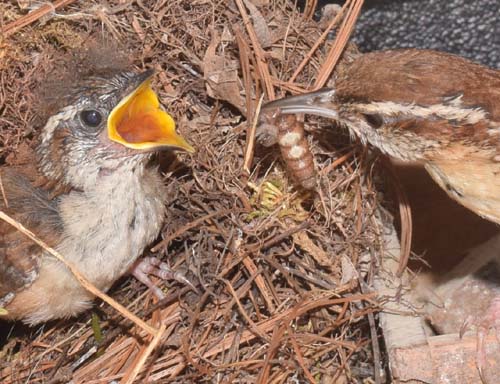
|
The wrens make a dent in the number of spiders in the workshop while they have nestlings to feed. They also find a great variety of creatures on the ground under the overgrown barnyard vegetation. Some are beheaded before presentation to a nestling.
|
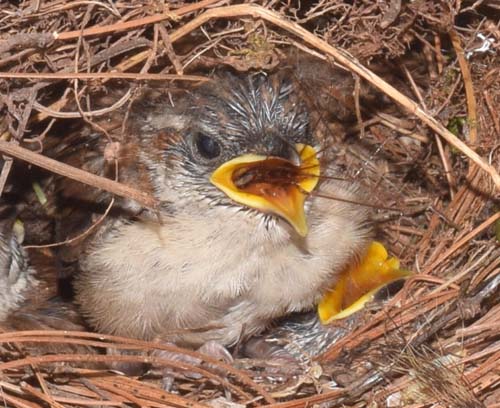
|
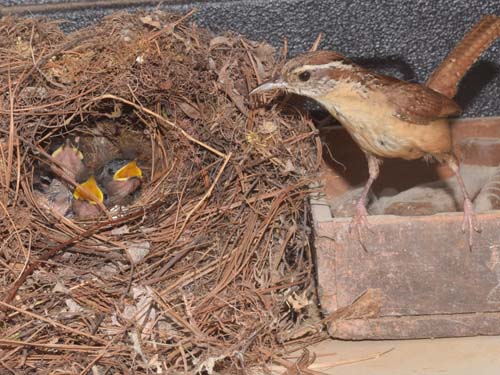
|
| March 15, 2021- This winter's frequent snows resulted in a much longer period of snow cover than usual. As a show of appreciation for the entertainment provided me by the Carolina wrens, I offered them their own source of suet and mealworms inside their barn. Now they don't have to wait their turn while the various woodpeckers and other species monopolize the outdoor feeder. Occasionally, even in winter, the male will break out in song when I am in the barn. Today, the ground is bare, and the wrens are on the third floor, picking flies off the south windows. Soon, the nesting process will begin again. |
| |













